Latest Posts on the LHC Blog
|
Tropical Cyclone Classification Tropical cyclones with an organized system of clouds and thunderstorms with a defined circulation, and maximum sustained winds of 38 mph (61 km/h) or less are called “tropical depressions”. Once the tropical cyclone reaches winds of at least 39 mph (63 km/h) they are typically called a “tropical storm” and assigned a name.
If maximum sustained winds reach 74 mph (119 km/h), the cyclone is called:
- A hurricane in the North Atlantic Ocean, the Northeast Pacific Ocean east of the dateline, and the South Pacific Ocean east of 160°E, (The word hurricane comes from the Carib Indians of the West Indies, who called this storm a huracan. Supposedly, the ancient Tainos tribe of Central America called their god of evil “Huracan”. Spanish colonists modified the word to hurricane.),
- A typhoon in the Northwest Pacific Ocean west of the dateline (super typhoon if the maximum sustained winds are at least 150 mph / 241 km/h),
- A severe tropical cyclone in the Southwest Pacific Ocean west of 160°E or Southeast Indian Ocean east of 90°E,
- A severe cyclonic storm in the North Indian Ocean, and
- Just a tropical cyclone in the Southwest Indian Ocean.
Hurricanes are further classified according to their wind speed. The Saffir-Simpson Hurricane Wind Scale is a 1-5 rating based on the hurricane’s present intensity. This scale only addresses the wind speed and does not take into account the potential for other hurricane-related impacts, such as storm surge, rainfall-induced floods, and tornadoes.
Earlier versions of this scale – known as the Saffir-Simpson Hurricane Scale – incorporated central pressure and storm surge as components of the categories. However, hurricane size (extent of hurricane-force winds), local bathymetry (depth of near-shore waters), topography, the hurricane’s forward speed and angle to the coast also affect the surge that is produced.
For example, the very large Hurricane Ike (with hurricane force winds extending as much as 125 miles (200 kilometers) from the center) in 2008 made landfall in Texas as a Category 2 hurricane and had peak storm surge values of about 20 feet (6 meters). In contrast, tiny Hurricane Charley (with hurricane force winds extending at most 25 miles (40 kilometers) from the center) struck Florida in 2004 as a Category 4 hurricane and produced a peak storm surge of only about 7 feet (2.1 meters). These storm surge values were substantially outside of the ranges suggested in the original scale.
To help reduce public confusion about the impacts associated with the various hurricane categories as well as to provide a more scientifically defensible scale, the storm surge ranges, flooding impact and central pressure statements were removed from the scale and only peak winds are now employed.
Saffir-Simpson Hurricane Wind Scale
| Category/Wind Speed |
Damage |
Category
5≥157 mph
≥137 kts
≥252 km/h
Catastrophic damage will occur! |
- People, Livestock, and Pets
- People, livestock, and pets are at very high risk of injury or death from flying or falling debris, even if indoors in mobile homes or framed homes.
- Mobile Homes
- Almost complete destruction of all mobile homes will occur, regardless of age or construction.
- Frame Homes
- A high percentage of frame homes will be destroyed, with total roof failure and wall collapse. Extensive damage to roof covers, windows, and doors will occur. Large amounts of windborne debris will be lofted into the air. Windborne debris damage will occur to nearly all unprotected windows and many protected windows.
- Apartments, Shopping Centers, and Industrial Buildings
- Significant damage to wood roof commercial buildings will occur due to loss of roof sheathing. Complete collapse of many older metal buildings can occur. Most unreinforced masonry walls will fail which can lead to the collapse of the buildings. A high percentage of industrial buildings and low-rise apartment buildings will be destroyed.
- High-Rise Windows and Glass
- Nearly all windows will be blown out of high-rise buildings resulting in falling glass, which will pose a threat for days to weeks after the storm.
- Signage, Fences, and Canopies
- Nearly all commercial signage, fences, and canopies will be destroyed.
- Trees
- Nearly all trees will be snapped or uprooted and power poles downed. Fallen trees and power poles will isolate residential areas.
- Power and Water
- Power outages will last for weeks to possibly months. Long-term water shortages will increase human suffering. Most of the area will be uninhabitable for weeks or months.
Examples: Hurricane Mitch of 1998 was a Category Five hurricane at peak intensity over the western Caribbean. Hurricane Gilbert of 1988 was a Category Five hurricane at peak intensity and is the strongest Atlantic tropical cyclone of record. |
Category
4130-156 mph
113-136 kts
209-251 km/h
Catastrophic damage will occur! |
- People, Livestock, and Pets
- There is a very high risk of injury or death to people, livestock, and pets due to flying and falling debris.
- Mobile Homes
- Nearly all older (pre-1994) mobile homes will be destroyed. A high percentage of newer mobile homes also will be destroyed.
- Frame Homes
- Poorly constructed homes can sustain complete collapse of all walls as well as the loss of the roof structure. Well-built homes also can sustain severe damage with loss of most of the roof structure and/or some exterior walls. Extensive damage to roof coverings, windows, and doors will occur. Large amounts of windborne debris will be lofted into the air. Windborne debris damage will break most unprotected windows and penetrate some protected windows.
- Apartments, Shopping Centers, and Industrial Buildings
- There will be a high percentage of structural damage to the top floors of apartment buildings. Steel frames in older industrial buildings can collapse. There will be a high percentage of collapse to older unreinforced masonry buildings.
- High-Rise Windows and Glass
- Most windows will be blown out of high-rise buildings resulting in falling glass, which will pose a threat for days to weeks after the storm.
- Signage, Fences, and Canopies
- Nearly all commercial signage, fences, and canopies will be destroyed.
- Trees
- Most trees will be snapped or uprooted and power poles downed. Fallen trees and power poles will isolate residential areas.
- Power and Water
- Power outages will last for weeks to possibly months. Long-term water shortages will increase human suffering. Most of the area will be uninhabitable for weeks or months.
Examples: Hurricane Luis of 1995 was a Category Four hurricane while moving over the Leeward Islands. Hurricanes Felix and Opal of 1995 also reached Category Four status at peak intensity. |
Category
3111-129 mph
96-112 kts
178-208 km/h
Devastating damage will occur. |
- People, Livestock, and Pets
- There is a high risk of injury or death to people, livestock, and pets due to flying and falling debris.
- Mobile Homes
- Nearly all older (pre-1994) mobile homes will be destroyed. Most newer mobile homes will sustain severe damage with potential for complete roof failure and wall collapse.
- Frame Homes
- Poorly constructed frame homes can be destroyed by the removal of the roof and exterior walls. Unprotected windows will be broken by flying debris. Well-built frame homes can experience major damage involving the removal of roof decking and gable ends.
- Apartments, Shopping Centers, and Industrial Buildings
- There will be a high percentage of roof covering and siding damage to apartment buildings and industrial buildings. Isolated structural damage to wood or steel framing can occur. Complete failure of older metal buildings is possible, and older unreinforced masonry buildings can collapse.
- High-Rise Windows and Glass
- Numerous windows will be blown out of high-rise buildings resulting in falling glass, which will pose a threat for days to weeks after the storm.
- Signage, Fences, and Canopies
- Most commercial signage, fences, and canopies will be destroyed.
- Trees
- Many trees will be snapped or uprooted, blocking numerous roads.
- Power and Water
- Electricity and water will be unavailable for several days to a few weeks after the storm passes.
Examples: Hurricanes Roxanne of 1995 and Fran of 1996 were Category Three hurricanes at landfall on the Yucatan Peninsula of Mexico and in North Carolina, respectively. |
Category
296-110 mph
83-95 kts
154-177 km/h
Extremely dangerous winds will cause extensive damage. |
- People, Livestock, and Pets
- There is a substantial risk of injury or death to people, livestock, and pets due to flying and falling debris.
- Mobile Homes
- Older (mainly pre-1994 construction) mobile homes have a very high chance of being destroyed and the flying debris generated can shred nearby mobile homes. Newer mobile homes can also be destroyed.
- Frame Homes
- Poorly constructed frame homes have a high chance of having their roof structures removed especially if they are not anchored properly. Unprotected windows will have a high probability of being broken by flying debris. Well-constructed frame homes could sustain major roof and siding damage. Failure of aluminum, screened-in, swimming pool enclosures will be common.
- Apartments, Shopping Centers, and Industrial Buildings
- There will be a substantial percentage of roof and siding damage to apartment buildings and industrial buildings. Unreinforced masonry walls can collapse.
- High-Rise Windows and Glass
- Windows in high-rise buildings can be broken by flying debris. Falling and broken glass will pose a significant danger even after the storm.
- Signage, Fences, and Canopies
- Commercial signage, fences, and canopies will be damaged and often destroyed.
- Trees
- Many shallowly rooted trees will be snapped or uprooted and block numerous roads.
- Power and Water
- Near-total power loss is expected with outages that could last from several days to weeks. Potable water could become scarce as filtration systems begin to fail.
Examples: Hurricane Bonnie of 1998 was a Category Two hurricane when it hit the North Carolina coast, while Hurricane Georges of 1998 was a Category Two Hurricane when it hit the Florida Keys and the Mississippi Gulf Coast. |
Category
174-95 mph
64-82 kts
119-153 km/h
Very dangerous winds will produce some damage. |
- People, Livestock, and Pets
- People, livestock, and pets struck by flying or falling debris could be injured or killed.
- Mobile Homes
- Older (mainly pre-1994 construction) mobile homes could be destroyed, especially if they are not anchored properly as they tend to shift or roll off their foundations. Newer mobile homes that are anchored properly can sustain damage involving the removal of shingle or metal roof coverings, and loss of vinyl siding, as well as damage to carports, sunrooms, or lanais.
- Frame Homes
- Some poorly constructed frame homes can experience major damage, involving loss of the roof covering and damage to gable ends as well as the removal of porch coverings and awnings. Unprotected windows may break if struck by flying debris. Masonry chimneys can be toppled. Well- constructed frame homes could have damage to roof shingles, vinyl siding, soffit panels, and gutters. Failure of aluminum, screened-in, swimming pool enclosures can occur.
- Apartments, Shopping Centers, and Industrial Buildings
- Some apartment building and shopping center roof coverings could be partially removed. Industrial buildings can lose roofing and siding especially from windward corners, rakes, and eaves. Failures to overhead doors and unprotected windows will be common.
- High-Rise Windows and Glass
- Windows in high-rise buildings can be broken by flying debris. Falling and broken glass will pose a significant danger even after the storm.
- Signage, Fences, and Canopies
- There will be occasional damage to commercial signage, fences, and canopies.
- Trees
- Large branches of trees will snap and shallow rooted trees can be toppled.
- Power and Water
- Extensive damage to power lines and poles will likely result in power outages that could last a few to several days.
Examples: Hurricanes Allison of 1995 and Danny of 1997 were Category One hurricanes at peak intensity. |
|
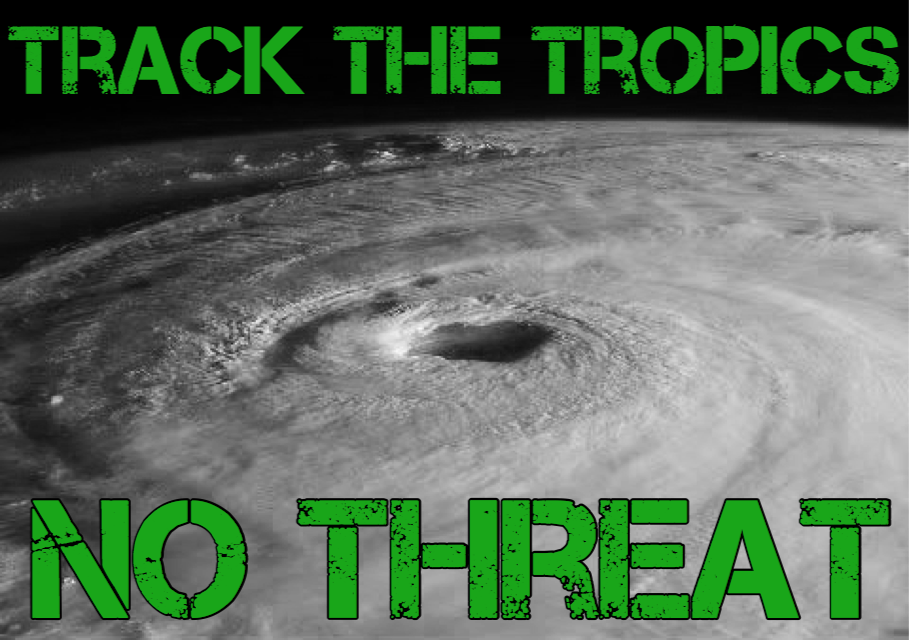
![[Map of 1950-2017 CONUS Hurricane Strikes]](http://www.nhc.noaa.gov/climo/images/conus_strikes_sm.jpg)
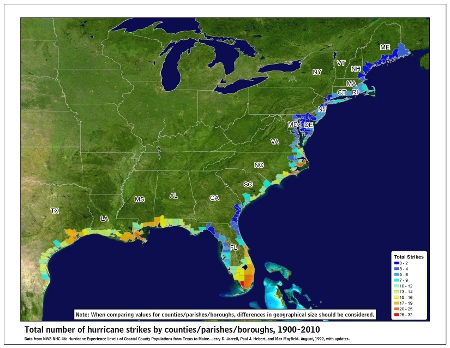
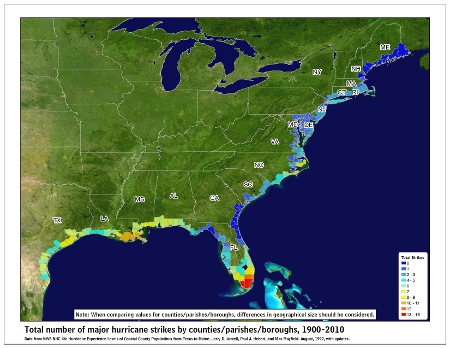
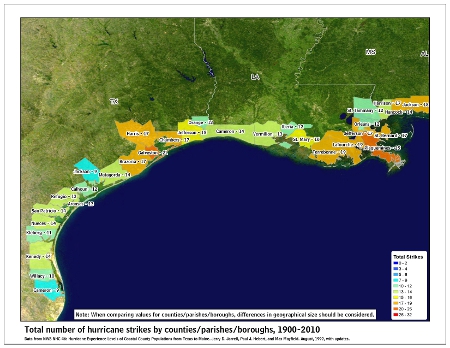
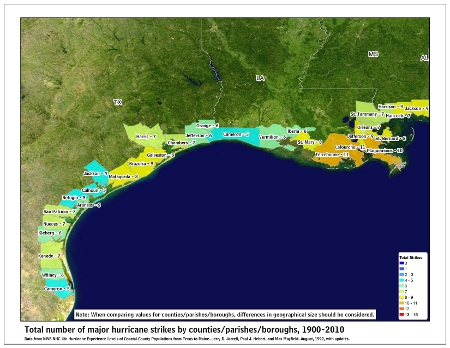
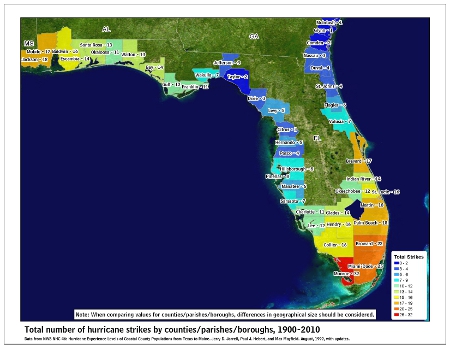

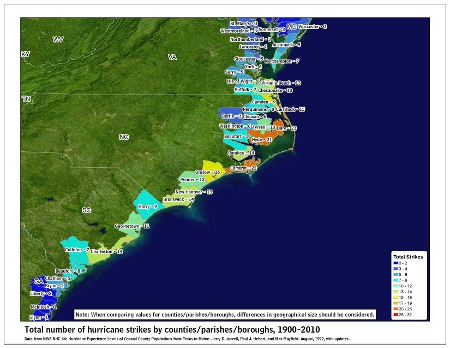
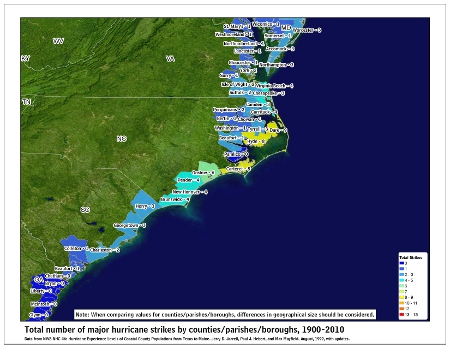
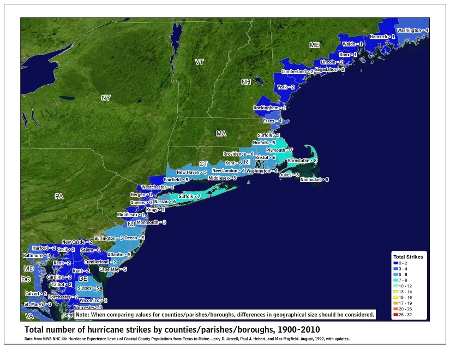
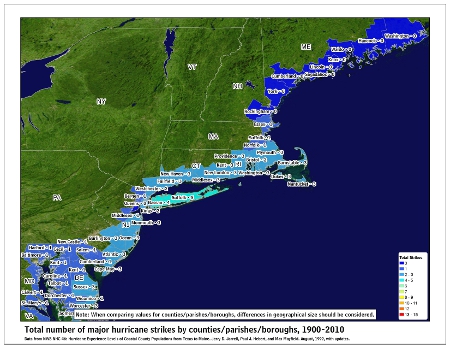
Facebook Comments